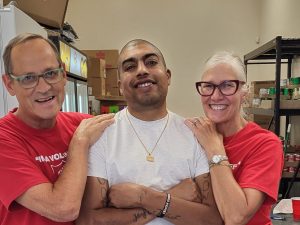CAPTAINS RHONDA AND Chris Matthias at the distribution center in the Bahamas. |
The devastation caused by this year’s Atlantic hurricane season—which isn’t over yet—is no longer front-page news but people throughout the Caribbean still face a daily struggle to rebuild their lives. Homes have been destroyed, businesses shattered and usual sources of income such as tourism and agriculture decimated. The Salvation Army is doing all it can to help people on the road to recovery.
On the island nation of Grenada, a team of Caribbean Salvation Army officers and volunteers, assisted by a consultant from International Headquarters, is coordinating deliveries of food, water and building supplies to families in need. Working with other relief groups, The Salvation Army is bringing hope. “We’re doing our best to make our limited resources stretch as far as possible,” says Major Stanley Griffin, team leader on Grenada. “The need here is staggering but every shipment of relief supplies gives the people a new reason to be optimistic.” For now, the major focus of Salvation Army relief efforts is to identify neglected communities. Heroic efforts to help are being undertaken by Salvationists from Bermuda and Barbados, but much more assistance is urgently needed.
In the Bahamas, progress is also being made—albeit slowly. Just as people began to recover after a direct hit from Hurricane Frances they were struck again by Hurricane Jeanne. Families who had returned home to begin making repairs had to seek the safety of shelters again. Once more they encountered Salvation Army personnel working tirelessly to serve their immediate needs. In the Bahamas, and especially in Freeport, people are seeing they can depend on The Salvation Army.
The people of Haiti are facing difficulties as they try to cope with a tremendous loss of life and property following Hurricane Jeanne’s visit to their island. Damage from winds was minimal but the deforestation of much of the island led to massive flooding and mud slides that left more than 1,000 people dead and many thousands more homeless. In one community a Salvation Army building was one of only a few to survive the flooding. Hundreds of people seeking shelter and comfort were welcomed into the compound. Many are still there—they have nowhere else to go.
Money for food, water and other relief supplies is urgently needed to help local Salvationists address the suffering that is still taking place.
In Jamaica, first impressions can be deceiving. In some of the larger cities, like Kingston and Montego Bay, life appears to be getting back to normal. But that’s definitely not the case in many of the more rural communities. And as local Salvation Army volunteers still reach out to give aid to affected communities a major concern continues to be damage to Salvation Army facilities across the island. Children’s homes, corps buildings and other properties essential to the Army’s vital ministry to thousands of Jamaicans have been badly damaged. Initial estimates are that repairs will cost more than $500,000.
Across the Caribbean The Salvation Army is working to bring healing and hope to many people who have lost everything. Donations will enable the Army’s disaster relief ministry to continue until life in the region returns to normal.
Report by International Emergency Services












